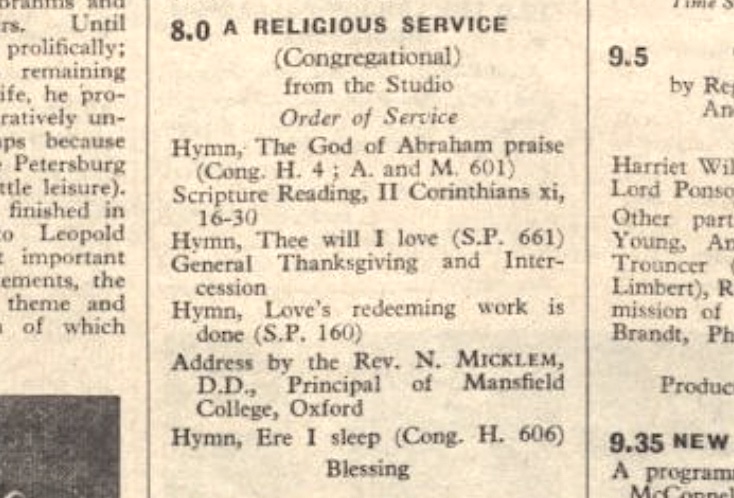OTD in early British television: 4 June 1939

John Wyver writes: One of the unremarked aspects of the pre-war television service (of which there are many) is the fact that from the start of 1939 around an hour of either the National of Regional Programme radio broadcasts were carried on the television frequency just ahead of the 9pm start of vision programming.
Mostly this hour was of classical music or variety, but on Sunday 4 June 1939 there was the religious service detailed in the Radio Times clipping above. Such services whether from the studio, as here, or as an OB from a church, were not otherwise carried on pre-war television, and only featured from late 1946 onwards.
The service was followed by The Week’s Good Cause, in this case on behalf of Central Council for the Care of Cripples, presented by (in language that is totally inappropriate today) ‘an unknown cripple’. After which there was ten minutes of the weather forecast, the forecast for shipping, and The Second News, broadcast simultaneously with the National Programme from the Daventry transmitter.
From the spring of 1937, driven both by a concern to raise television’s profile and by the hopes of savings, there was a series of largely unsuccessful attempts to ‘marry’ radio and television broadcasts. Shared variety programming was among the experiments that were tried, but logistical and creative problems defeated all of them.
Rumours swirled that, despite pressure from both executives and from set manufacturers, lowlier staff at Broadcasting House had no interest in establishing a proper relationship with the upstart service. For his part, director of television Gerald Cock was happy to keep his operation as distinct and as autonomous as possible.
The less challenging and complex form of ‘marriage’ underway by June 1939 had started at 8.15pm on 27 May 1938 when the television service took 20 minutes of the National Programme OB from the London Music Festival at Queen’s Hall.
After this relay of Arturo Toscanini conducting the BBC Symphony Orchestra, further Festival concert extracts followed, and these were succeeded by Promenade concert performances in August. As one commentator judged,
The reproduction is very striking and realistic… Owing to the wide band width available with this sound transmitter, all musical frequencies are radiated with very little distortion or attenuation.
An hour or so of the 1938 Proms continued to be offered most evenings at 8pm until the Last Night on 1 October, and then, as noted, from the start of January 1939 around an hour of either the National or Regional schedule became a fixture in this slot. Whether anyone ‘watched’ radio on their television set, however, appears to have left no trace in the archive.
[OTD post no. 169; part of a long-running series leading up to the publication of my book Magic Rays of Light: The Early Years of Television in Britain in January 2026.]
Leave a Reply